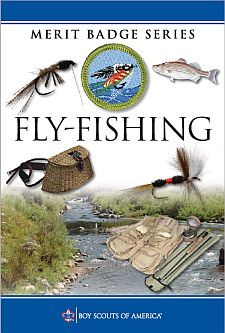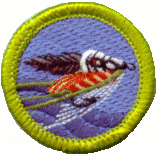- Do the following:
- Explain to your counselor the most likely hazards you may encounter while participating in fly-fishing activities and what you should do to anticipate, help prevent, mitigate, and respond to these hazards. Name and explain five safety practices you should always follow while fly-fishing.
- Discuss the prevention of and treatment for health concerns that could occur while fly-fishing, including cuts and scratches, puncture wounds, insect bites, hypothermia, dehydration, heat exhaustion, heatstroke, and sunburn.
- Explain how to remove a hook that has lodged in your arm.
- Demonstrate how to match a fly rod, line and leader to achieve a balanced system. Discuss several types of fly lines, and explain how and when each would be used. Review with your counselor how to care for this equipment.
- Demonstrate how to tie proper knots to prepare a fly rod for fishing:
- Tie backing to the arbor of a fly reel spool using an arbor knot.
- Tie backing to the fly line using a nail knot.
- Attach a leader to the fly line using a nail knot or a loop-to-loop connection.
- Add a tippet to a leader using a surgeon's knot or a loop-to-loop connection,
- Tie a fly onto the terminal end of the leader using an improved clinch knot.
- Explain how and when each of the following types of flies is used: dry flies, wet flies, nymphs, streamers, bass bugs, poppers , and saltwater flies. Tell what each one imitates. Tie at least two types of the flies mentioned in this requirement.
- Demonstrate the ability to cast a fly 30 feet consistently and accurately using both overhead and roll cast techniques.
- Go to a suitable fishing location and observe what fish may be eating both above and beneath the water's surface. Explain the importance of matching the hatch.
- Do the following:
- Explain the importance of practicing Leave No Trace techniques. Discuss the positive effects of Leave No Trace on fly-fishing resources.
- Discuss the meaning and importance of catch and release. Describe how to properly release a fish safely to the water.
- Obtain and review a copy of the regulations affecting game fishing where you live or where you plan to fish. Explain why they were adopted and what is accomplished by following them.
- Discuss what good sportsmanlike behavior is and how it relates to anglers. Tell how the Outdoor Code of the Boy Scouts of America relates to a fishing enthusiast, including the aspects of littering, trespassing, courteous behavior, "catch and release," and obeying fishing regulations.
- Catch at least one fish using a fly rod and a fly. Identify it and quickly release it live back into the water. Discuss this experience with your counselor.
- If regulations and health concerns permit, clean and cook a fish you have caught. If you are unable to catch a fish for eating, acquire a fish, clean the fish you acquired, and cook the fish you acquired. (It is not required that you eat the fish.)
BSA Advancement ID#:
136
Scoutbook ID#:
54
Requirements last updated in:
2021
Pamphlet Publication Number:
35900
Pamphlet Stock (SKU) Number:
E-Book Stock (SKU) Number:
Pamphlet Copyright Date:
|
|||||||
Page updated on: February 08, 2024









